15 Wildflowers That Grow in Iowa (Identification Guide with Pictures)
-
Jana Blagojevic
- Last updated:
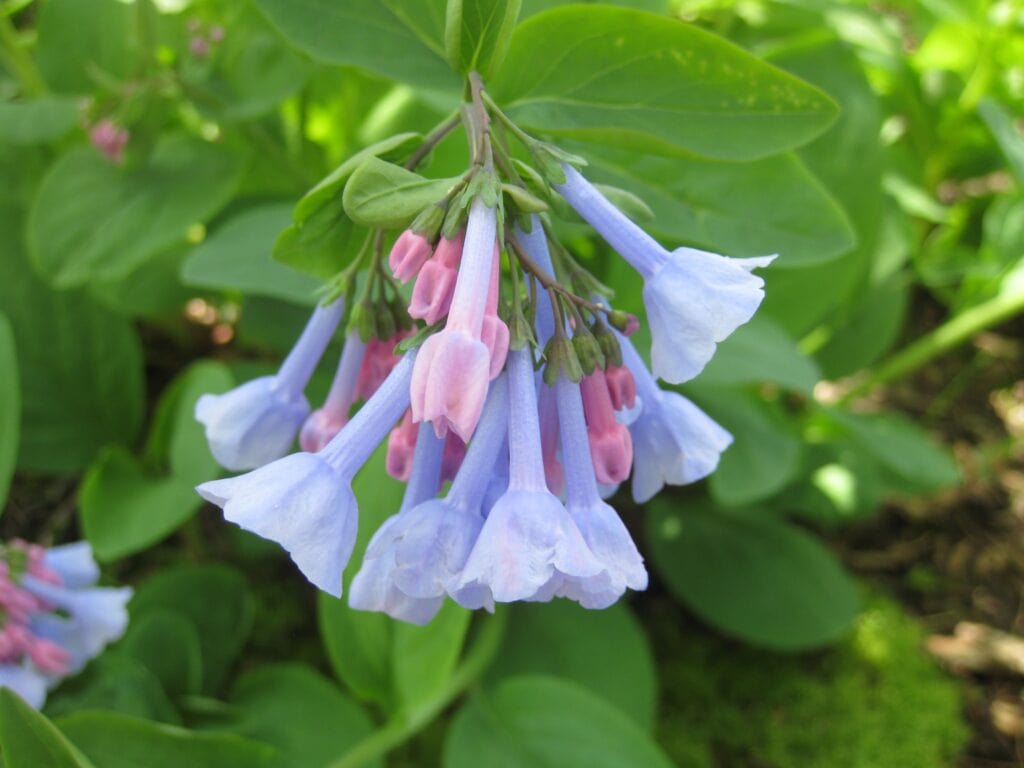
If you ever found yourself wandering through the prairies or meadows of Iowa, you probably noticed various wildflower species growing around you and coloring the scenery with magnificent, vibrant shades. Wanting to know the exact name of the wildflower species you come across is understandable, so we made a list of the most common wildflowers that grow in Iowa.
The 15 Common Wildflowers That Grow in Iowa
1. Butterfly Milkweed
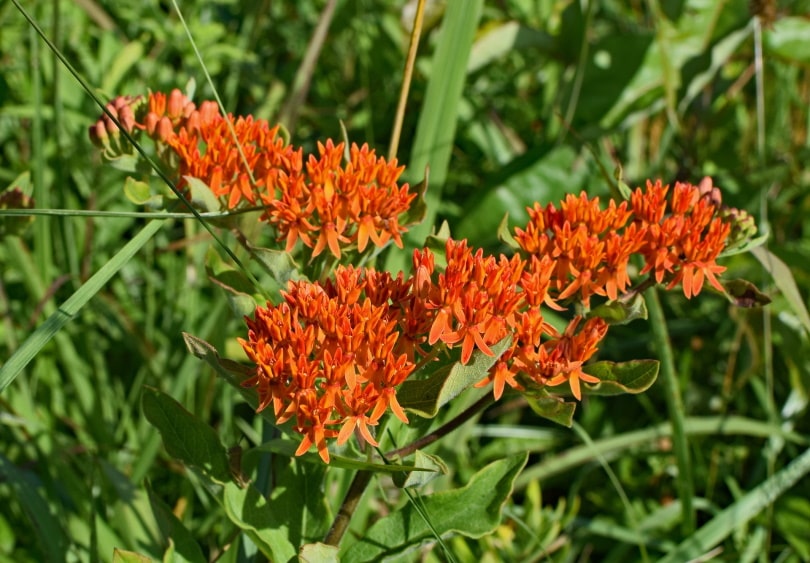
| Botanical name: | Asclepias tuberosa L. |
| Growing requirements: | Full sun exposure; well-drained sandy soil, tolerant of drought |
| Hardiness: | Zones 3 to 9 |
The butterfly milkweed is a very attractive bushy perennial that is common in many garden landscapes due to its vibrant colors. It can be spotted in prairies, woods, and hillsides of Iowa, where it will thrive in dry and sandy soil. It attracts many pollinator insects, and butterflies are not an uncommon sight among their flowers.
The flowers grow in wonderful bright orange clusters, from 2 to 5 inches in diameter. The leaves are long, smooth, and pointed, and the entire foliage appears dark green, contracting the gorgeous, vibrant flowers.
2. Compass Plant

| Botanical name: | Silphium laciniatum |
| Growing requirements: | Full sun exposure; a moist and loamy soil |
| Hardiness: | Zones 3 to 9 |
The Compass plant is a fantastic addition to any garden, with its delicate and soft appearance. These plants are incredibly tall and can grow up to 12 feet high, with large light-green leaves that are 24 inches in diameter. This plant can be seen in prairies, savannas, and tallgrass regions across Iowa. It adores basking in full sunlight and growing in moist or slightly dry soil.
The plant’s central stem is thickest, light green, with tiny white hairs covering its entire surface. The flowering stems are branching with lovely, yellow, daisy-like flowers.
3. Ironweed
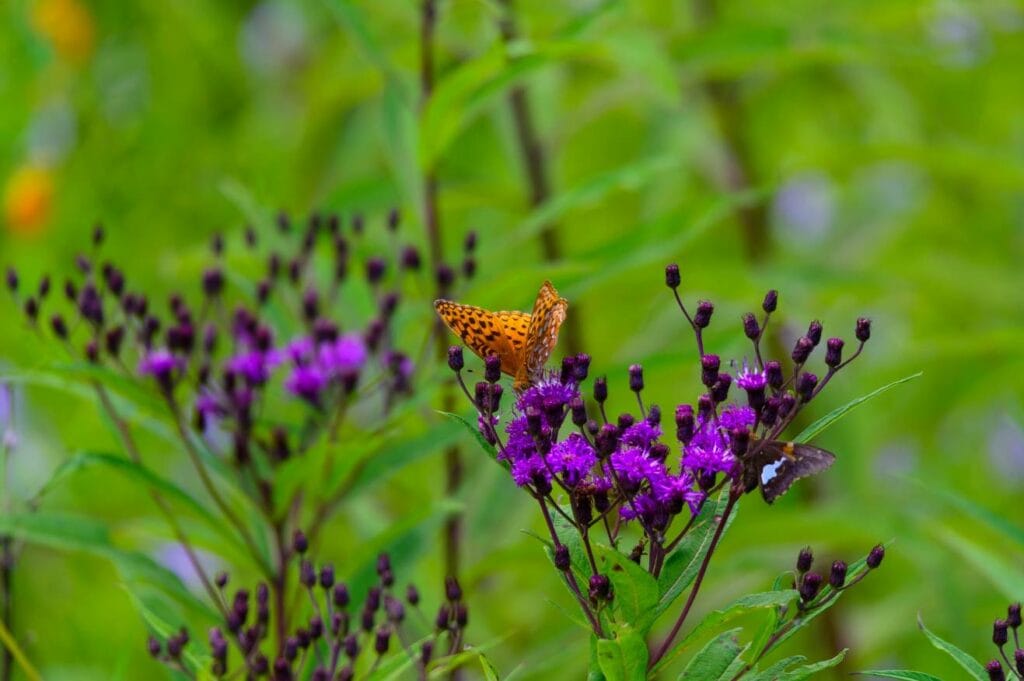
| Botanical name: | Vernonia fasciculata |
| Growing requirements: | Full sun or partial shade; moist, rich, and slightly acidic soil |
| Hardiness: | Zones 4 to 8 |
Ironweed is a wonderful pop of color, especially during the late season when its flowers appear bright purple. It is found in prairies, pastures, meadows, and anywhere where the soil is rich, sandy, or loamy. This plant is considered a weedy wildflower, although it doesn’t become invasive. Because of its unusual height of up to 6 feet, It is ideal for borders, screens near fences, and cottage gardens.
The flowers are tiny, fluffy, and colored in a lovely violet-purple. The leaves are deep green, with a coarse texture, growing up to 5 inches in diameter.
4. Prairie Sage

| Botanical name: | Artemisia ludoviciana |
| Growing requirements: | Full sun and shade; dry, well-drained soil |
| Hardiness: | Zones 4 to 9 |
The prairie sage is a magnificent wildflower that’s fast spreading in the form of a bushy clump. It grows up to 3 feet tall and wide and spreads aggressively if all the right growing conditions are met. It thrives in moderately rich or poor dry soil, basking in full sun exposure. It is perfect for garden beds and borders near a herb or a cottage garden.
The foliage of the prairie sage is tinted in a stunning silvery-white, with foliage that lets out a pleasant fragrance once bruised. It grows tiny yellow to gray flowers, which should be removed when noticed.
5. Evening Primrose

| Botanical name: | Oenothera biennis |
| Growing requirements: | Full sun; moist, well-drained soil, neutral or acidic |
| Hardiness: | Zones 4 to 9 |
The evening primrose is a very attractive, erect biennial with a unique name. It has an unusual habit of opening its flowers in the evening and closing them before noon. Its seeds are a valuable food source for birds, and its roots are also edible. It usually grows on dry and rocky plains, open woods, and lake shores. It is thieves in sunlight but is tolerant of shady areas as well.
The flowers are almost always large and yellow, with a unique lemon scent. Stems are covered in tiny hairs and usually have a purple tint.
6. Wild Bergamot
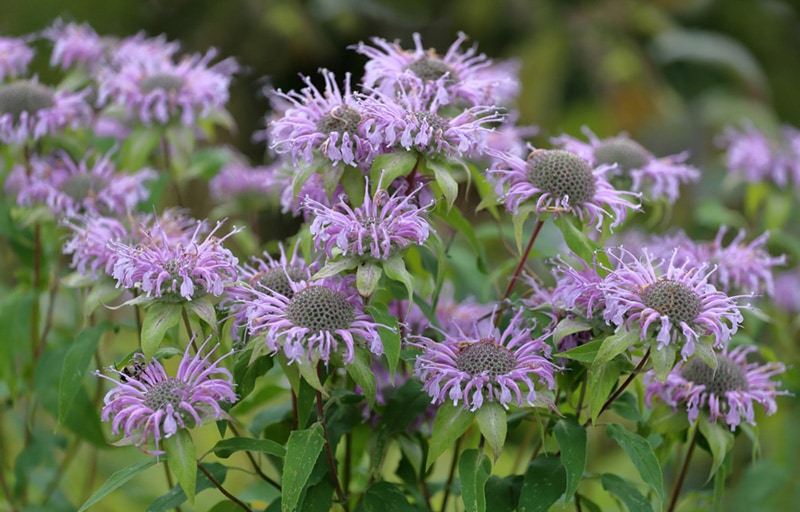
| Botanical name: | Monarda fistulosa |
| Growing requirements: | Full sun; well-drained and sandy soil |
| Hardiness: | Zones 4 to 9 |
Wild bergamot is a widespread wildflower seen in dry and rocky woods and along roads and roadsides of the US. It tolerates most conditions, although it loves sandy, moderately dry soil. It also looks lovely planted next to herb gardens, perennial borders, and in other naturalized areas. Its showy lavender flowers attract many pollinators, including hummingbirds and butterflies.
This flower will provide a splash of color in any garden. The foliage is gentle and slightly fragrant, making it easy to recognize in the wild.
7. Purple Prairie Clover

| Botanical name: | Dalea purpurea |
| Growing requirements: | Full sun exposure; dry to moist, well-drained soil |
| Hardiness: | Zones 3 to 8 |
A native to American prairies, the purple prairie clover is a lovely wildflower. It is a perfect decorative plant for wild gardens, rock gardens and borders, and other naturalized areas. It adores full sun exposure throughout the day and soil with excellent drainage properties. This plant is resistant and tolerant of most conditions, including heat and drought. If all the ideal growing conditions are provided, this plant will self-seed.
Recognizing this plant in the wilderness is easy enough, with the lovely purple knobby flower heads growing on top of wiry stems.
8. Cup Plant

| Botanical name: | Silphium perfoliatum L. |
| Growing requirements: | Full sun exposure; rich, moist, alkaline soil |
| Hardiness: | Zones 3 to 9 |
The cup plant is another perennial example of an Iowa wildflower growing up to 9 feet high. It is mostly found in prairies and moist wooded areas, with very little maintenance and care needed. The gorgeous flowers will attract hummingbirds and butterflies, helping the plant pop up anywhere where the conditions allow it. The plant got its name from the stout leaves connecting at the stem, forming small cups. These cups retain water and quickly attract birds.
The flowers on the cup plant are large and almost always yellow, with dark yellow centers and around 20 small petals.
9. Yellow Coneflower
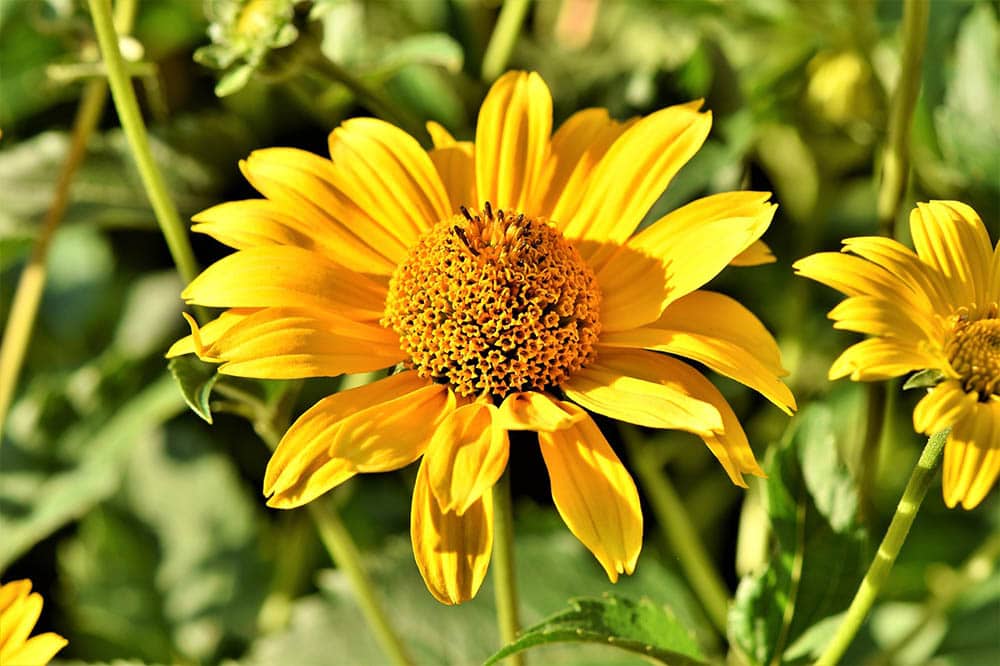
| Botanical name: | Ratibida pinnata |
| Growing requirements: | Morning sun, afternoon shade; well-drained, slightly acidic soil |
| Hardiness: | Zones 3 to 9 |
The yellow coneflower is a perennial wildflower native to Missouri, although widespread across prairies, dry woods, and railroads of Iowa. The plant can grow up to 5 feet high, with erect, stiff stems. The stem is covered with tiny white hairs, with pinnately divided leaves growing on the base.
The flower heads of the yellow coneflower grow on top of branched stems. The yellow rays of flower petals grow downwards, drooping away from the center. The center is thick, dark brown, and when bruised, it lets out a soft anise aroma.
10. Culver’s Root

| Botanical name: | Veronicastrum virginicum |
| Growing requirements: | Full sun exposure; moderately wet, well-drained soil rich in humus |
| Hardiness: | Zones 3 to 8 |
The Culver’s root is a stunning hardy perennial, growing up to 6 feet tall and spreading 4 feet wide. It is very easy to grow and tolerant of most soil conditions. It is perfect for adding a unique appearance to the landscape and can be grown as an accent plant in wildflower or cottage gardens and other naturalistic plantings.
The stems and flowers of the Culver’s root resemble a candelabra, with erect and fluffy flower heads, which can be purple, white, pink, and blue.
11. Wild Ginger
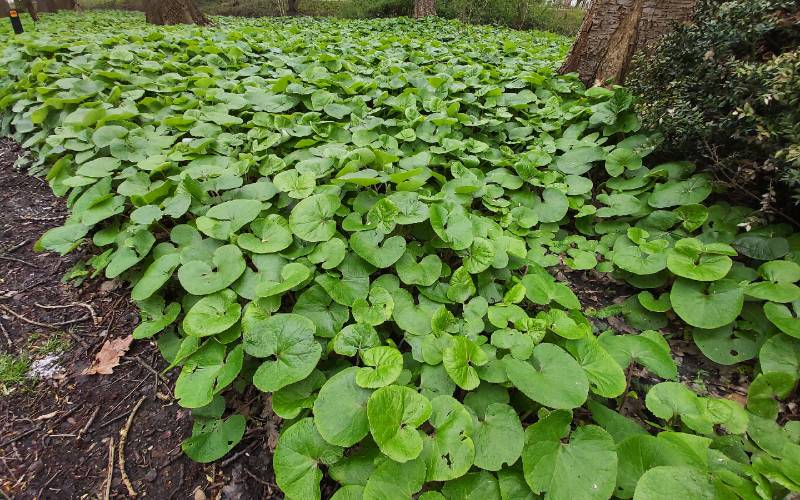
| Botanical name: | Asarum canadense |
| Growing requirements: | Partial shade or full shade; moderately wet soil with excellent draining properties |
| Hardiness: | Zones 4 to 6 |
Wild ginger is a lovely, low-growing perennial usually spotted in rich woods and wooded slopes across the United States, including Iowa. It is tolerant of most growing conditions, although it will thrive in shaded areas and constantly moist soil. While this plant is not related to ginger, which we commonly use in the kitchen, it still has a pleasant aroma similar to ginger.
It is a stemless plant with unique heart-shaped leaves, which grow slowly to form a ground cover. The flowers are purple to brown, shaped like cups, and grow from tiny, ground-level stems.
12. Blue False Indigo
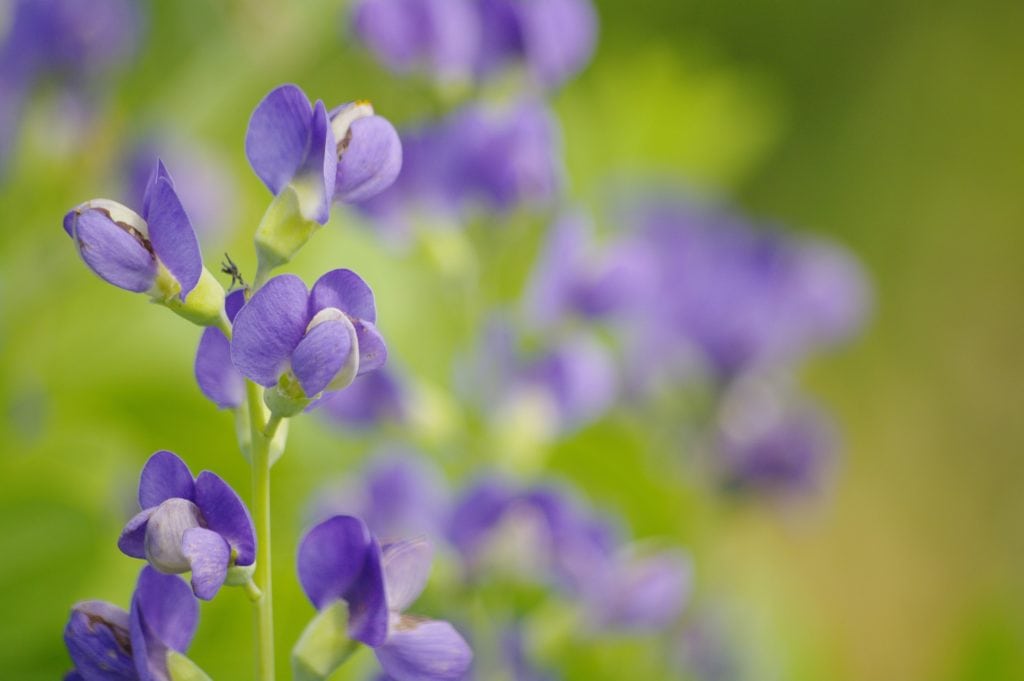
| Botanical name: | Baptisia australis |
| Growing requirements: | Plenty of natural sunlight; moderately wet soil, well-drained |
| Hardiness: | Zones 3 to 9 |
The blue false indigo is another very attractive, bushy perennial growing along the wood edges and prairies. It can grow to 5 feet tall and 3 feet wide and prefers acidic soil. It rises from woody stems into bushy foliage. In the fall, the plant turns silvery-gray and breaks off at the base to tumble in the wind.
The flowers are small and pea-like, growing in dense, erect spikes in blue or purple. The flower heads can grow to be 16 inches long.
13. Wild Petunia

| Botanical name: | Ruellia humilis |
| Growing requirements: | Tolerant of partial shade and full sun exposure; sandy, rocky, or loamy soil |
| Hardiness: | Zones 4 to 8 |
Wild petunia is a beautiful perennial, widespread across the prairies and meadows of North America. It grows low, only up to 24 inches tall and wide. It is a lovely addition to rock gardens or native plant gardens and will thrive in full sun exposure or partial shade. The gorgeous flowers attract bees and butterflies to your garden.
The flower heads are shaped like bells, resembling petunias. Flowers are purple or blue, tubular, and around 3 inches long. The leaves are soft green, covered with tiny hairs.
14. Virginia Bluebells
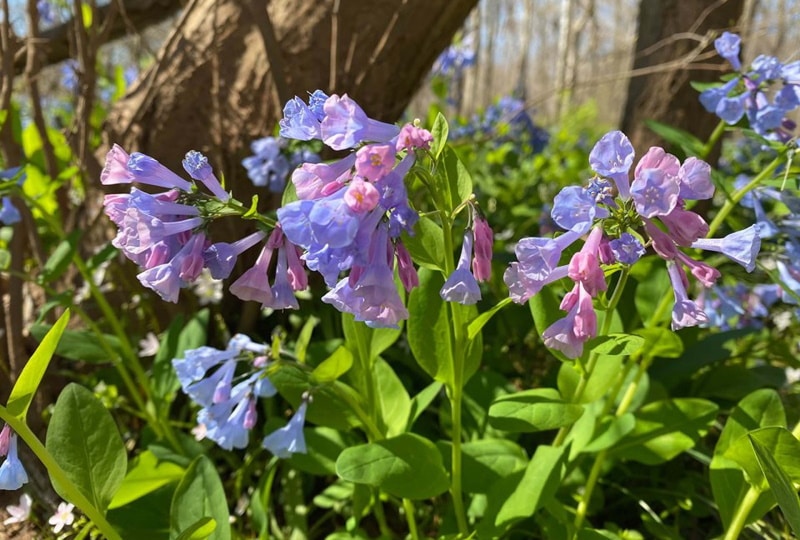
| Botanical name: | Mertensia virginica |
| Growing requirements: | Partial or full shade; neutral or slightly acidic soil with well-drained properties |
| Hardiness: | Zones 3 to 8 |
The Virginia bluebell is a stunning perennial, growing in rich woods and near rivers. It grows up to 2 feet tall and 1.5 feet wide. The leaves are very smooth and oval, and the entire foliage dies off by mid-summer when the plant is dormant. The plant is easy to care for and tolerant of most soil types, although it thrives in moist and rich soil.
The flowers are blue and shaped like tiny, charming trumpets. The flower buds emerge pink and eventually turn blue.
15. Wild Mint

| Botanical name: | Mentha arvensis |
| Growing requirements: | Full sun or light shade; tolerant of most soil types, loamy, sandy, and even heavy clay |
| Hardiness: | Zones 4 to 8 |
The wild mint, or Mentha arvensis, is a very aromatic perennial, growing in moist areas along streams, marshes, and ponds. This plant is unique for its glands which contain fragrant essential oils. The leaves of the wild mint are commonly used in the kitchen, for adding flavor to certain spices, and in popular beverages such as teas or cocktails.
The leaves grow in opposite pairs at a node, hiding small, bell-shaped flowers at the top. The flowers range from white and pale pink to a distinctive lavender shade.
Conclusion
After reading this article, you will have enough knowledge to wander through meadows and even the roadsides of Iowa and identify the most common wildflowers. Each of these wildflowers has a unique trait, which will help you spot them easily. Finding plants can become much more rewarding once you know which plants to look for and their unique characteristics.
Featured Image Credit: Jumpstory
Contents
